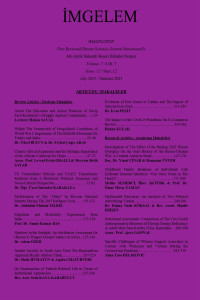Öz
The main objective of this research note is to find out if Kant’s theory of modernity helps us understand the nature of migration in present-day India. This note makes a plea for differentiating the two moments of modernity and deriving their varying implications for migration in India. In the existing literature on migration in South Asia in general and India in particular their difference is too easily overlooked. Kant, while representing its first moment, would have viewed migration as a patently modernist aspiration on the part of the people to come to States ‘with a law-governed condition’ from States that lack it. He would have expected that dispersal of ‘a law-governed civil condition’ uniformly across the globe would settle the population within the State territories in a stable way. As ‘a law governed civil condition’ (which he considered as the hallmark of modernity) could not be established uniformly across the globe and there seems to be no concerted global effort at settling the population in a stable way, Kantian mission today remains by and large abandoned. Modernity has entered its second moment when such stable settlement of population is considered impossible and it becomes imperative on a State’s part to attempt at governing the migrants, rather than trying to do the impossible task of completely stopping their flow. Here, we refer to a few of these technologies that are deployed, among others, to govern the forced and undocumented migrants reportedly pouring in from the neighbouring States of South Asia. In an engagement with the current debate, the note makes a study of the updating of National Register of Citizens and Citizenship Amendment Act in India.
Anahtar Kelimeler
Citizenship National Register of Citizens Migration, Modernity
Kaynakça
- Baruah, S. (2020). Non-Citizens and History, S. Bhaumik, S. Purkayantha & S. Chaudhury (Eds.), in NRC Factsheet: Compendium of Media Articles (35-39), Kolkata: Calcutta Research Group.
- Bhaumik, S. (1999). Insurgent Crossfire: North-East India, New Delhi: Lancer.
- Das, S. K. (1992-3). Immigration and Agricultural Modernisation: The Case of Assam (1979-83), Socialist Perspective, 20 (3&4), 165-75.
Öz
The main objective of this research note is to find out if Kant’s theory of modernity helps us understand the nature of migration in present-day India. This note makes a plea for differentiating the two moments of modernity and deriving their varying implications for migration in India. In the existing literature on migration in South Asia in general and India in particular their difference is too easily overlooked. Kant, while representing its first moment, would have viewed migration as a patently modernist aspiration on the part of the people to come to States ‘with a law-governed condition’ from States that lack it. He would have expected that dispersal of ‘a law-governed civil condition’ uniformly across the globe would settle the population within the State territories in a stable way. As ‘a law governed civil condition’ (which he considered as the hallmark of modernity) could not be established uniformly across the globe and there seems to be no concerted global effort at settling the population in a stable way, Kantian mission today remains by and large abandoned. Modernity has entered its second moment when such stable settlement of population is considered impossible and it becomes imperative on a State’s part to attempt at governing the migrants, rather than trying to do the impossible task of completely stopping their flow. Here, we refer to a few of these technologies that are deployed, among others, to govern the forced and undocumented migrants reportedly pouring in from the neighbouring States of South Asia. In an engagement with the current debate, the note makes a study of the updating of National Register of Citizens and Citizenship Amendment Act in India.
Anahtar Kelimeler
Kaynakça
- Baruah, S. (2020). Non-Citizens and History, S. Bhaumik, S. Purkayantha & S. Chaudhury (Eds.), in NRC Factsheet: Compendium of Media Articles (35-39), Kolkata: Calcutta Research Group.
- Bhaumik, S. (1999). Insurgent Crossfire: North-East India, New Delhi: Lancer.
- Das, S. K. (1992-3). Immigration and Agricultural Modernisation: The Case of Assam (1979-83), Socialist Perspective, 20 (3&4), 165-75.
Ayrıntılar
| Birincil Dil | İngilizce |
|---|---|
| Konular | Siyaset Bilimi |
| Bölüm | Makaleler |
| Yazarlar | |
| Yayımlanma Tarihi | 30 Temmuz 2023 |
| Gönderilme Tarihi | 25 Mayıs 2023 |
| Kabul Tarihi | 14 Temmuz 2023 |
| Yayımlandığı Sayı | Yıl 2023 Cilt: 7 Sayı: 12 |

This work licensed under a Creative Commons Attribution-NonCommercial 4.0 International License.
Please click here to contact the publisher.


